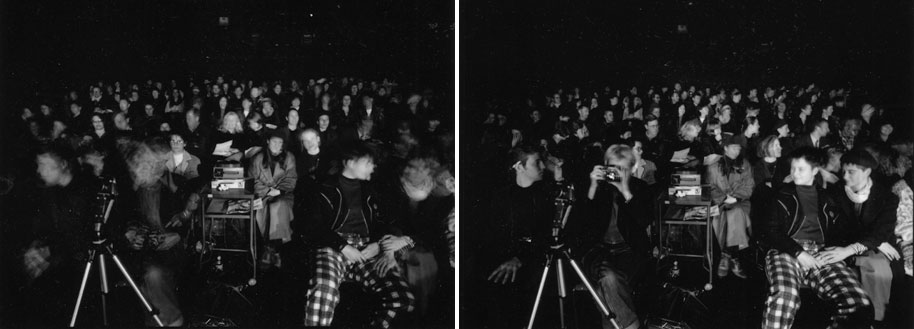| The Incrimination of Light (part I) | |||
|
|||
The audience is seated in the theatre. The performer enters the space and places a large format camera on the stage, facing them. The lights fade out leaving the theatre in total darkness. The aperture of the camera is fully opened and the shutter locked into a position allowing all available light to be recorded. After a few seconds of dark adaptation(necessary for the eyes to accommodate to the darkness) the audience is subjected to five bursts of flash, providing them with numerous afterimages and recording them on film. The flashes end leaving the audience in total darkness to view the temporal images imprinted on their retinas. They are then instructed to turn left, where they are once again photographed. They are then asked to turn to the right and the process is repeated. Once this is complete the audience is asked to leave the space. The setting up of the camera in full view of the audience foreshadows the exchanging power relationships about to occur (the inevitability of audience as subject and performer). Here the camera embodies the panopticon, its ever watchful eye hidden by the absence of light. Its gaze cannot be successfully returned. Subject to that gaze is the audience, who embody both observer and performer simultaneously. Aware of their position as the target of the cameras gaze they monitor their actions. The flash provides the momentary illumination necessary for the indelible imprint to appear on the negative, whilst informing the audience of the photographic moment, the capture and their incrimination. Barthes describes the cameras uncanny ability to evoke the performative through the unsettling powers of the lens:"Once I feel myself observed by the lens, everything changes: I constitute myself in the process of "posing", I instantaneously make another body for myself, I transform myself in advance into an image." (Camera Lucida p 10 ). The Photograph. Sontag's morbid yet potent description of the photograph seems to resonate in the above works. The context surrounding the photographic act in the incrimination of light embodies the notion of violation and photographic possession. Such analysis is especially pertinent to the first of the trilogy where the crowd are symbolically incarcerated. The communal turn of the head reminiscent of criminal "mug shots" taken by police. Their identity is recorded as offender, guilty before the fact. Yet as images removed from performance context, they are curious anomalies which become "inexhaustibleinvitations to deduction, speculation and fantasy." P 23 Susan Sontag, On photography.
|
The Incrimination of Light |
||
| < | > | |||
